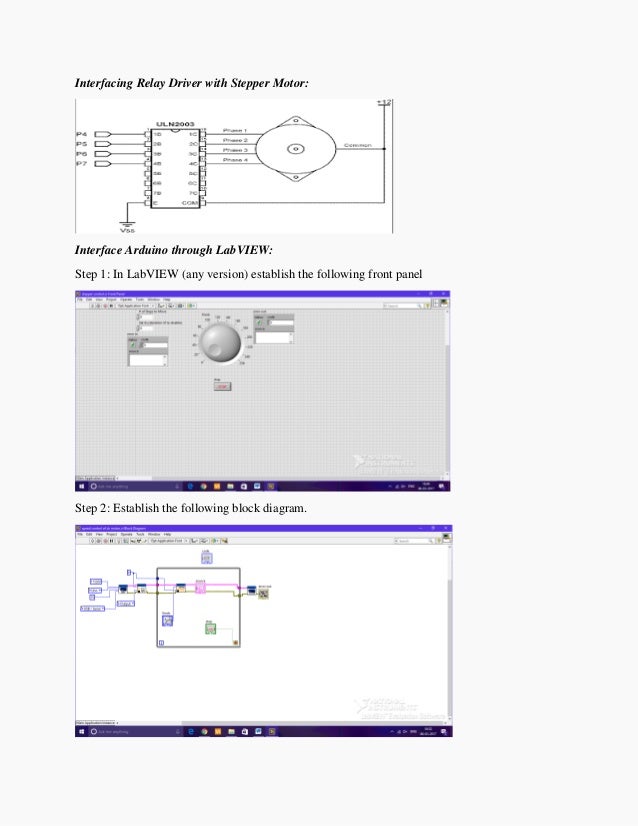

- #Servo motor arduino labview full
- #Servo motor arduino labview series
SG90 is a low cost and high output power servo motor. Let us show you one application of the rotary encoder where we will use it to control a SG-90 servo motor. If (current_stateCLK != last_stateCLK & current_stateCLK = 1) Controlling Servo Motor using Rotary Encoder ModuleĪs discussed earlier, rotary encoders are very useful. CLK and DT pins produce square waves which are 90 degree out of phase with each other and these two square waves are used to measure clock wise and anti clock wise rotation of shaft.
#Servo motor arduino labview series
Two light emitting diodes (LEDs) are connected at pins CLK and DT with the help of two 220 ohms resistor which are connected in series with these light emitting diodes. The DT pin is also used to determine the rotation but lags the DLK by 90 degree phase shift. Its output goes from HIGH to LOW (one cycle) whenever the knob of the rotary encoded is rotated by one click. The CLK pin gives the main output pulse which is used to determine the rotation. The rotary encoder thus also acts as a push button. When we push the knob of the rotary encoder from the top, the voltage goes LOW. The SW is the switch pin that gives the output of the active low push button switch. These voltages should be with in the range of 3.3 volts to 5 volts for normal working of this encoder. The GND pin is connected to ground and positive voltages are applied at + pin. Rotary encoder module consists of five pins such as CLK, DT, SW, + and GND. The one we are using is the output rotary encoder and it is the simplest one. There are many types of rotary encoders available which are either classified as the output signal or the sensing technology. Most have 12 steps, but they can be up to 200. On many rotary encoders, when you will move it, you will feel a bump. The rotary encoder has no start, middle, or end, so you can rotate it as much as you want. These can be used to control the brightness of the LED, controlling the servos, and many other things. It generates an analog or digital signal depending on the rotational movement. It determines the amount and the type of rotation. Control DC Motor using Rotary Encoder and ArduinoĪ rotary encoder is such a type of encoder which is used for measuring the angular position of any rotating shaft. Control LED Brightness with Rotary Encoder and Arduino. Arduino Sketch: Controlling Servo Motor using Rotary Encoder Module. Interfacing Rotary Encoder Module with Arduino UNO and SG-90 servo motor. Controlling Servo Motor using Rotary Encoder Module. Reading Rotary Encoders using Interrupts. Arduino Sketch: Reading Rotary Encoders. Interfacing Rotary Encoder with Arduino. The below page is somewhat old, but it gives a good idea of just what is in a servo and how it works. Some of these values date back to the older analog RC equipment. #Servo motor arduino labview full
I think there needs to be a minimum of ~5us wait between pulses to the servo for the servo to accept the next pulse as a new command, so the full 20ms wait is not required for a new sequence. One could use an o-scope to see just how far the timing limits can be pushed. The servo library allows the default values to be changed in the "servo.attach" function. The servo.cpp library contains the "default" us values as "default min is 544, max is 2400" microseconds. I think the standard spec for RC servo equipment is only +-45 deg rotation, so that is probably the reason the 1000 to 2000 µS range is referenced. OK, so the servo is following specs, but how come all the references above mention 1000 to 2000 µS, and how come the servo library defaults to providing the correct pulse width? I found a page that specifies the pulse width for this particular servo as: So I measured the pulse widths and found they were 0.5 mS to 2.5 mS which is not what all the above references suggest. Myservo.write(val) // sets the servo position according to the scaled valueĭelay(15) // waits for the servo to get there Val = map(val, 0, 1023, 0, 180) // scale it to use it with the servo (value between 0 and 180) Val = analogRead(potpin) // reads the value of the potentiometer (value between ) Myservo.attach(9) // attaches the servo on pin 9 to the servo object

Int val // variable to read the value from the analog pin

Int potpin = 0 // analog pin used to connect the potentiometer Servo myservo // create servo object to control a servo Then I tried a test sketch from the Servo library (part of the IDE I think) namely: #include In setting up a test however I found that a 1 to 2 mS pulse width only moved the servo partly around its travel.







 0 kommentar(er)
0 kommentar(er)
